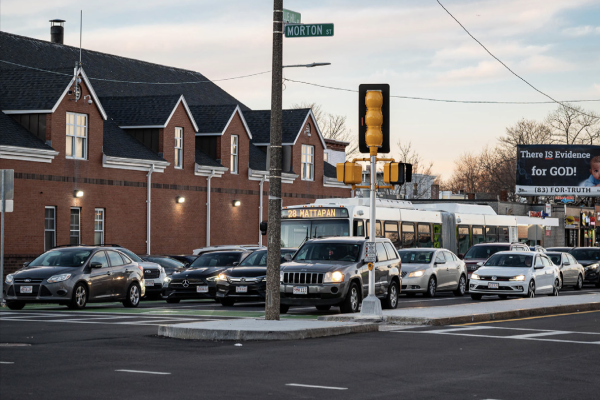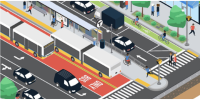March 1, 2024

An MBTA bus alongside other traffic at the Blue Hill Avenue-Morton Street intersection. City of Boston/MBTA photo

A city, state and federally-funded plan to revamp Blue Hill Avenue with center-running bus lanes and other modern infrastructure is drawing negative reviews from some in Dorchester and Mattapan, who say they feel frustrated that their input was not factored into the decision to move forward with the $44 million project.
And while Mayor Wu, Congresswoman Pressley and other elected leaders have pledged a “block-by-block” engagement process to inform any final design elements, neighbors say they aren’t confident that their voices will be heard in that process either.
“There’s nothing about it I like,” said Barbara Crichlow, a Mattapan resident, who shared her thoughts during a break at the Mildred Avenue Community Center, where seniors gather weekly.
Her friend Glenola Mitchell agreed, saying she and her fellow seniors don’t feel safe walking across Blue Hill Avenue to a center-lane bus platform. They don’t think it would be safe for children either.
“Their plan is going to put others at risk,” said Mitchell. “The first thing I thought when I saw their rendering was it’s going to cost someone their life because it’s absurd. When you look at the broad width of the roadway by the (Mattapan) library, I don’t know how that will work.”
Crichlow said she feels city planners who sought input from her and other Mattapan neighbors wasted her time.
“We told them and they did exactly what they wanted anyway. It’s like any project presented to the city, they ask us and then do what they want. I’m heated, and I am not impressed,” said Crichlow.
At the Carter American Legion Post 16 in Mattapan Square, Mary-dith Tuitt had strong words against the plan, which she reviewed personally last year when the city hosted a meeting about the project at the post, where she served as commander. She worries that the re-design will eliminate precious parking spaces near the post, which counts on party rentals to keep the doors open.
“It's a shame that they wasted two years of our time with meetings knowing they were going to do what they wanted anyway,” she said. “It was like a parent saying, ‘If you do the work, you will get what you want.' We did the work and the parent said, ‘But this is better for you.’ The city wasn't listening and was going to do the center bus lane even though we don't want it.”
The voices of dissent stand in stark contrast to much of officialdom who herald the public works project as a landmark moment for the corridor. In addition to Mayor Wu and Congresswoman Pressley, leaders like State Rep. Russell Holmes, Councillor Enrique Pepen, Mattapan transit activist Vivien Ortiz, and Grove Hall Main Streets Director Ed Gaskin, stressed the benefits for 37,000 bus riders along the corridor.
But other elected officials who haven’t been publicly supportive of the idea say they’ve been barraged with phone calls and taken to task at the grocery store, the dry cleaners, or at local restaurants. State Rep. Chris Worrell has generally supported the mayor on most initiatives, but said he has strong reservations about the Blue Hill Avenue plan.
“As someone who has lived my entire life right off of Blue Hill Ave and owned a business there, I understand the concerns of many residents and business owners,” Worrell said. “We all know that traffic issues need to be addressed. However, any proposed change of this magnitude needs overwhelming community support and a real opportunity for input.”
Other elected officials applauded the $44 million investment, but noted the full design plan is not yet finalized.
“Blue Hill Ave is a major thoroughfare in our city with long-standing commercial districts and has lacked proper investment for a long time,” said state Rep. Brandy Fluker-Oakley. “Our community deserves transit-friendly roads that both drivers and pedestrians feel comfortable using regularly. Double parking is a constant reality on Blue Hill Ave, and the City of Boston must ensure that the needs of our small businesses and their patrons are prioritized so that they can sustain and flourish.”
Added State Sen. Liz Miranda, who represents the entire Blue Hill corridor from Mattapan Square to Dudley Street: “I am grateful for the public investment in the corridor, which will enable improved safety for students and seniors, while improving the built infrastructure with new sidewalks, crosswalks, tree canopy, and lighting. Hearing both positive and concerning feedback from constituents, the part we can all agree on is that our neighborhood deserves the same investment as others across the City of Boston.”
The Greater Mattapan Neighborhood Council (GMNC) hasn’t embraced the plan either, even after two years of being the most active civic voice in the process. The group hosted a well-attended “block by block” planning exercise for Blue Hill Avenue last year. Fatima Ali-Salaam, who chairs the group, said her fellow members are puzzled at the price tag – pointing out the smaller Cummins Highway re-design has an investment of $32 million, while the larger Blue Hill Avenue corridor is only slightly bigger at just $44 million.
Beyond that, she said the GMNC has demanded that all projects consider public health outcomes and job creation, and interconnectedness to the rest of the city.
“If you’re not approaching it as an integrated city with an entire network, you’re not connecting people to the city as a whole,” she said. “You’re not thinking about it as people who are going through their entire day going to school and to jobs and entertainment arts venues and the rest of the city.
“You can’t just be doing things to do things if you’re not addressing health outcomes, and Mattapan has some of the worst health outcomes for children” she added. “It’s about people, jobs, public health, and public safety. If you’re going to do it and not address those things and just do it half-hearted, don’t even put a shovel in the ground.”
Major churches on the corridor are not as critical.
Jubilee Church Pastor Matthew K. Thompson, and Morningstar Baptist Church Bishop John Borders III are mainly voicing support, although Borders has concerns.
Pastor Thompson said Jubilee would not be affected because they have a large parking lot. Beyond that, he said he has always been supportive of transit solutions that bring economic empowerment – as did the Blue Hill Avenue commuter rail stop next to his church.
“I’ll never be a disparaging voice of the economic empowerment of our city,” he said. “When the commuter rail was proposed to locate next to the church, I was for that. I see the positives in that way, but I do understand what it will do for other businesses and churches with the traffic and flow. I empathize with them and understand, but I am for (the project) and support it.”
Rev. Borders also supports it but worries that Blue Hill Avenue could change like the South End, leaving large historically Black churches with no local congregants and churches disbanded or sold for housing conversions. That, he said, worries him.
“Overall, we know it will be an economic boom for our neighborhoods,” he said. “One of my primary concerns is that Blue Hill Avenue does not become what the South End has become for Black and Brown churches and businesses…We must address the parking issue. Parking is a problem now. If we lose parking, we hurt churches and businesses currently sustaining the corridor.”
He noted that Pressley, Wu, Holmes, and Council President Ruthzee Louijeune, who also supports the plan, have committed to ongoing conversations over the next year.
“They assure us that no church or business will be ignored or displaced. I believe we will create the most efficient plan possible for our families and businesses,” he added.
Elsewhere along the avenue, merchants are less confident.
Peter Papadogiannis, who has spent 11 hours a day since 1981 operating Mattapan’s Boulevard Cleaners and Tailors in the 1300th block, calls the center-lane bus “the wrong idea.” He recommends e a smaller center lane for frequent emergency vehicles that send gridlocked drivers into a panic, but he isn’t sure anyone seriously considered his idea.
“That’s my opinion. They’re going to affect the businesses too because where will people park? Now it’s two lanes and people double park, and if you put it down to a single lane, it’s going to be chaos…I just hope they don’t do it the way they’re talking about now.”
He added: “Then there’s the bike lanes. If I see two or three bikes go by the whole day, that’s a lot. I don’t know why they need that here.”
The city has noted it will begin comprehensive meetings on the plan as early as this spring, going block-by-block to determine the layout of the roadway to inform a final design. Construction is pinpointed to begin on the larger items, like the bus lane, in 2026. Smaller, less controversial fixes will start in a few months.


